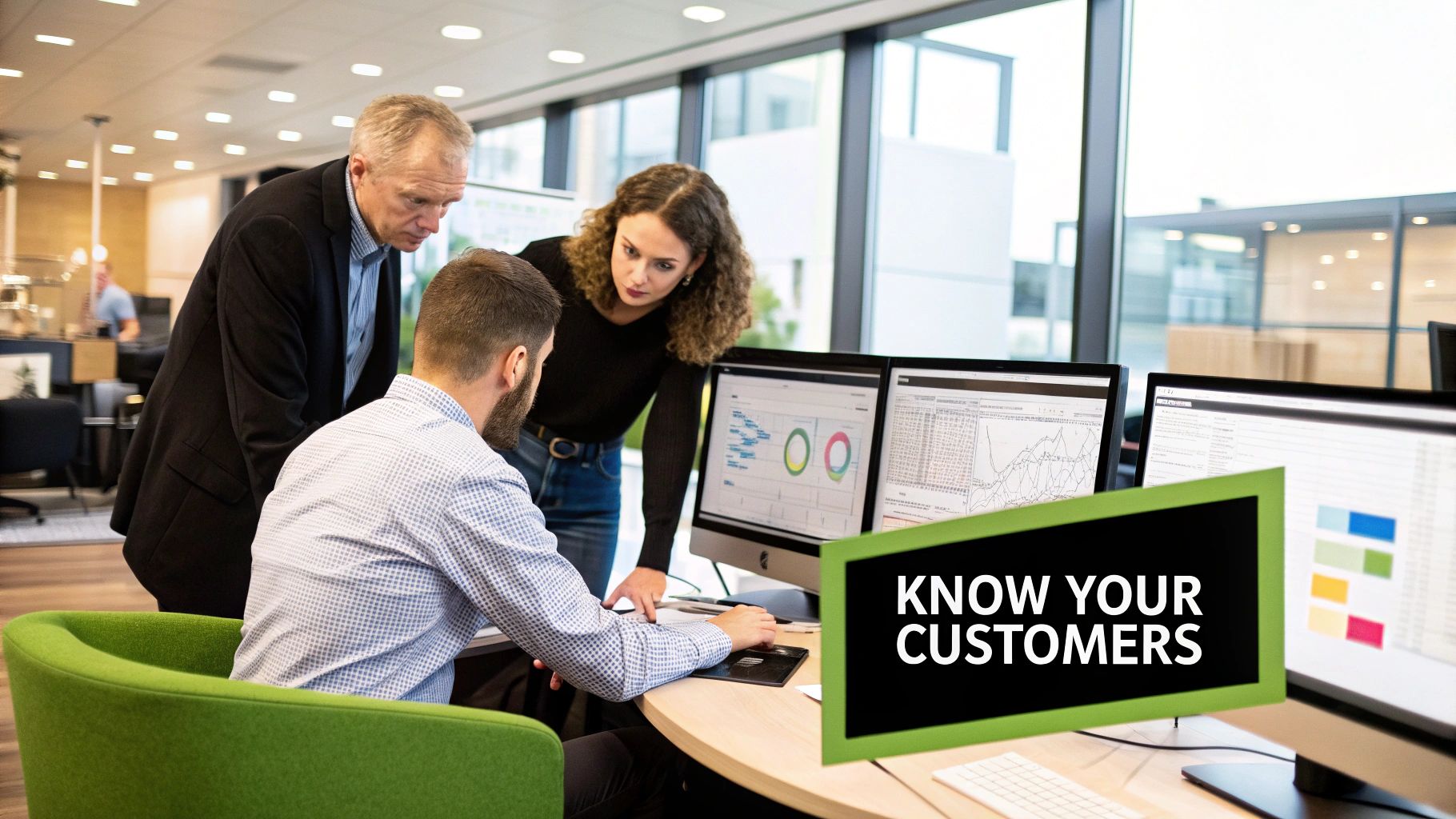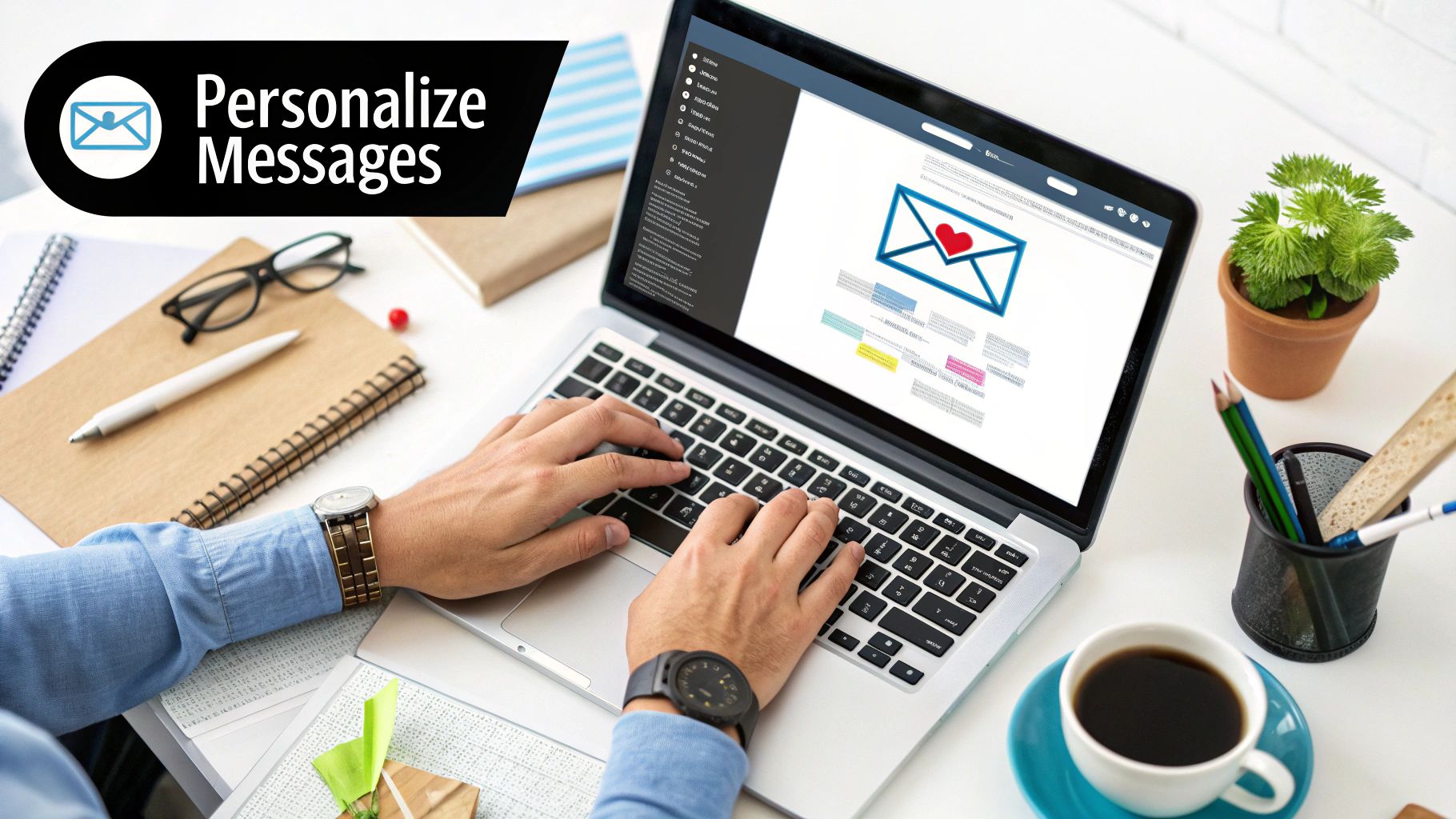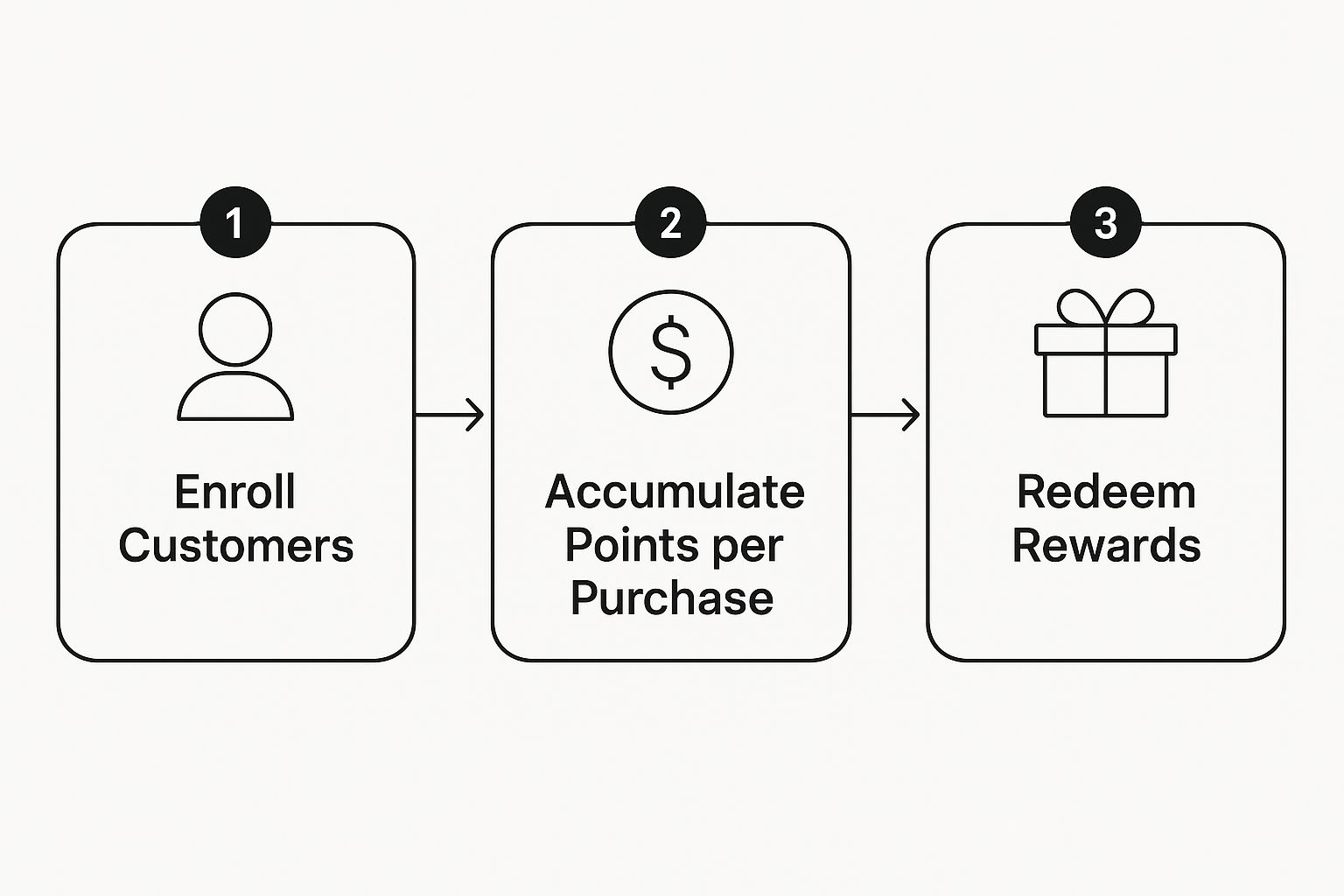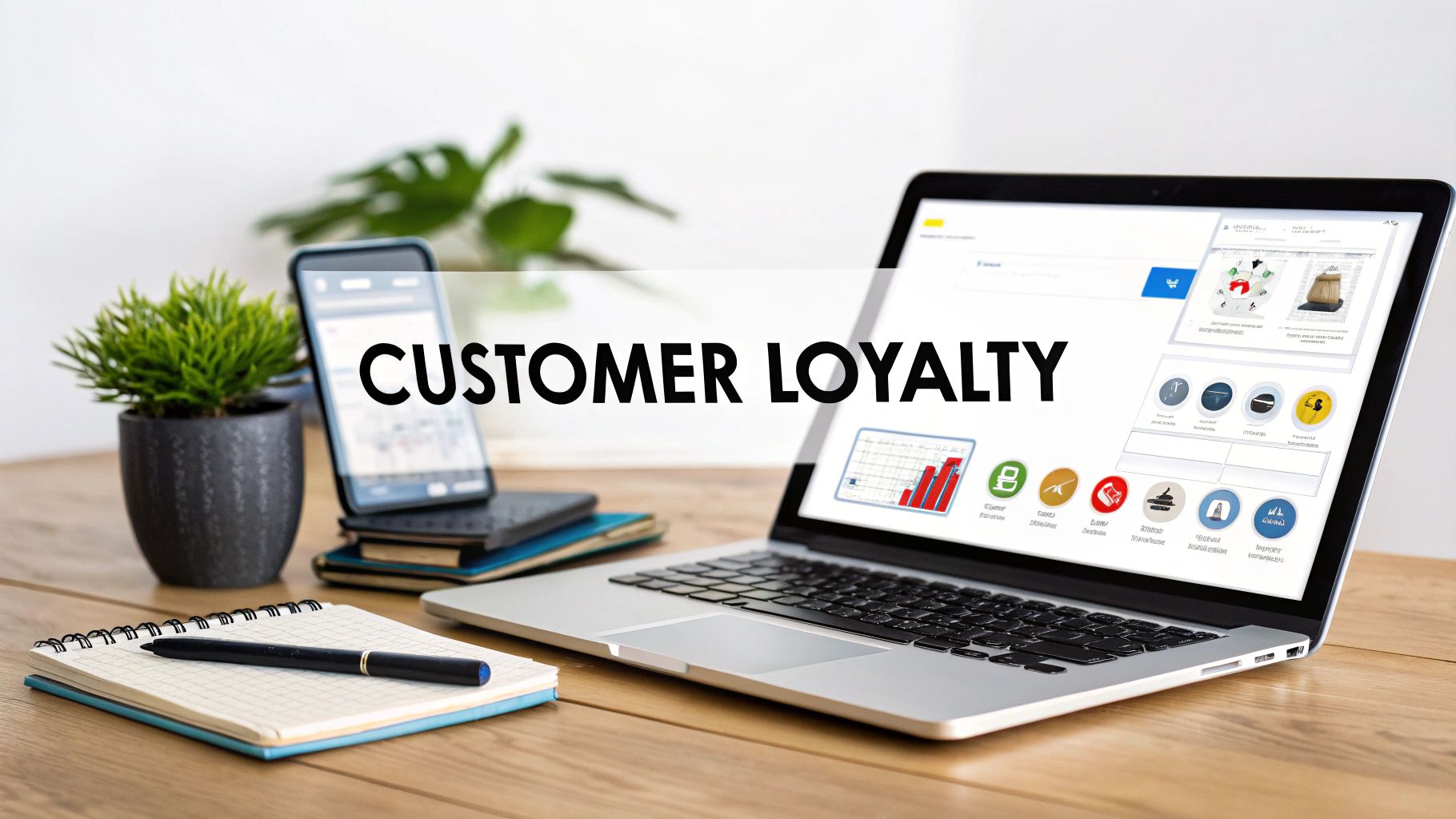Let's be real: pouring money into ads to find new customers feels like you're on a treadmill. You run faster and faster, but your store's growth barely budges. After working with over 500 Shopify stores, we've seen this costly mistake time and again. Brands get obsessed with acquisition while their existing customers—the ones who could be their most profitable asset—quietly walk away.
The hard truth is, with customer acquisition costs soaring nearly 60% in five years, you're likely losing money on that first sale. The secret to building a truly profitable e-commerce business isn't just getting the first sale; it's earning the second, third, and fourth. That's how to build customer loyalty that fuels sustainable growth. In this guide, you'll learn exactly how to turn one-time buyers into loyal fans using practical, data-driven strategies you can implement today.
Why Customer Loyalty Is Your Most Valuable Asset

From our experience with hundreds of Shopify stores, we see a common—and expensive—mistake. Brands pour their entire budget into chasing new customers, all while their existing ones quietly slip away. This "leaky bucket" approach is a constant, uphill battle against rising ad costs and shrinking profit margins.
The simple fact is that acquiring a new customer costs far more than keeping an existing one. This isn’t just a marketing theory; it's a financial reality that directly hits your bottom line. With the cost to acquire a new customer having surged by nearly 60% over the last five years, many brands are actually losing money on the first sale. You can see more of the data behind these loyalty trends on Emarsys.com.
The numbers don't lie. Focusing your energy on the customers you already have is one of the smartest financial decisions you can make.
The Financial Reality of Acquisition vs. Retention
This table makes the business case crystal clear. While you always need a stream of new customers, building a solid retention strategy is what creates a truly profitable and resilient business.
The Kanal Expert Takeaway: A small 5% increase in customer retention can boost your profits by anywhere from 25% to 95%. It’s a powerful multiplier effect. From what we've seen, loyal customers buy more often, their Average Order Value (AOV) tends to be higher, and because they trust you, they are less sensitive to price and more willing to try new products.
The Shift from Satisfaction to Trust
In a crowded market, a "satisfied" customer is no longer a guarantee of future business. Satisfaction is temporary. Someone might like the product they bought, but without a real connection to your brand, they’re easily lured away by a competitor's discount or a slicker ad.
This is why we push brands to aim higher than just satisfaction. The goal is to build genuine trust.
Trust is the bedrock of real loyalty. It’s what shifts a relationship from being purely transactional to something more meaningful. When customers trust you, they believe in your brand’s promise and feel confident that shopping with you is the right decision, every time. You can see exactly how we put this principle into action in our e-commerce marketing playbooks. This is how you build a business that doesn't just survive on an endless cycle of ad spend, but actually thrives on the strength of its customer relationships.
Moving Beyond Satisfaction to Build Real Trust

Here’s a hard truth we've learned from scaling hundreds of brands: a satisfied customer is not always a loyal one. A common mistake we see is merchants celebrating a 5-star review as a win for loyalty, but that initial satisfaction can be incredibly fragile. The customer got what they paid for, sure, but without a real connection, they're just one competitor's discount code away from leaving you.
This creates a dangerous gap. Research from Qualtrics confirms it: while overall consumer satisfaction might look healthy, the metrics that actually drive growth—like trust, advocacy, and repurchase intent—often tell a different story. Even happy customers aren't automatically coming back. You can see the full breakdown of these loyalty gaps in the research on Qualtrics.com.
To build loyalty that actually moves the needle, you have to get past the one-off transaction. The real goal is building genuine, unshakable trust.
From Transactional to Relational
So, what’s the secret? It’s about shifting your communication from purely transactional to truly relational. You have to start talking to your customers like people, not just order numbers. This is the heart of what’s known as conversational marketing, where you swap out one-way announcements for genuine, two-way dialogues.
A simple post-purchase check-in via WhatsApp, with its 98% open rates, can do more for trust than a dozen generic marketing emails ever could. Instead of just another "Your order has shipped" notification, imagine sending a message like this:
- "Hey [Customer Name], just checking in! How are you liking your new [Product Name]?"
- "Did you have any questions about setting it up? We're here to help!"
This simple, helpful approach shows you care about their experience after you’ve already made the sale. It's a small gesture, but it has a massive impact on how a customer perceives your brand.
The Power of Proactive Support
In our experience, the brands that absolutely crush it on loyalty are the ones that solve problems before their customers even know they exist. A customer who trusts you isn't just someone who likes your products; they're someone who believes you'll have their back if something goes wrong.
The Kanal Expert Takeaway: Trust is built in the moments between purchases. It's the proactive shipping update when a carrier is delayed, the quick setup tip for a new product, or the simple "thank you" message sent a month after their order. These small, consistent touchpoints are how you build an unbreakable bond.
Every one of these interactions chips away at the "faceless online store" perception and builds your reputation as a reliable partner. It's this deep-seated trust that turns a satisfied, one-time buyer into a loyal advocate who not only keeps coming back but also tells their friends about you.
Building Your Loyalty Engine with WhatsApp
This is where the rubber meets the road—turning your loyalty strategy into a real, working system. You can't just cross your fingers and hope customers come back. You have to actively engage them where they live, and for the e-commerce brands we work with, that channel is overwhelmingly WhatsApp. Its 98% open rates are practically unheard of anywhere else.
Email loyalty programs often get buried in a promotions tab or a cluttered inbox. A WhatsApp message, on the other hand, feels immediate and personal. This is how you start genuine conversations that build loyalty, not just send another notification that goes unread.
Let's get practical. Here are three must-have automated flows you can set up in a tool like Kanal right now to start turning one-time buyers into genuine fans.
The Post-Purchase Check-In Flow
A common mistake we see is brands going completely radio silent after a purchase. The relationship doesn't end at the "thank you" page; that’s actually where the real work of building loyalty begins. The most powerful first move is a simple, non-promotional check-in.
- Trigger: Set this to send about 7 days after an order is marked as delivered.
- Goal: The aim here isn't to sell. It's to show you genuinely care about their experience with the product. This single act builds a massive amount of trust.
- Example Message: "Hey [Customer Name]! It's [Your Name] from [Your Brand]. Just wanted to pop in and see how you're enjoying your new [Product Name]? Hope you're loving it! Let me know if you have any questions at all."
This flow does more than just show you care; it opens a direct line for feedback and proves you're a partner, not just a retailer. It’s a low-effort, high-impact play that lays the groundwork for everything that follows.
The Educational Drip Flow
Your customers bought your product to solve a problem or achieve a specific goal. Your job now is to help them get the absolute most value out of that purchase. An educational drip campaign positions you as a helpful expert, not just another company trying to sell more stuff.
This approach is gold for products that have even a slight learning curve—think specialty coffee equipment, multi-step skincare routines, or technical outdoor gear.
- Trigger: A good time for this is about 3 days after your initial post-purchase check-in.
- Goal: To provide value completely separate from the sale. This reinforces their decision to buy from you and helps ensure they have a great experience.
- Example Message: "Hi [Customer Name]! Quick tip for your [Product Name]: A lot of our clients find that [insert a helpful tip here] really makes a difference. Give it a try and let us know what you think!"
This simple process visualizes how you can structure a basic rewards system that is both easy for customers to understand and for you to implement.

The key is realizing that loyalty doesn't have to be some complicated, points-based behemoth. It’s about creating a clear, rewarding path that starts from the very first purchase.
The Exclusive 'Thank You' Offer
Okay, so you've built some trust and provided real value. Now is the perfect time to reward that loyalty and nudge them toward that all-important second purchase. This isn't a generic, site-wide sale blasted to everyone. This is a targeted, personal offer sent directly to your best customers on WhatsApp.
- Trigger: Fire this off right after a customer's second purchase is completed.
- Goal: To explicitly acknowledge and reward their repeat business. This makes the customer feel seen and valued, creating a powerful incentive to come back again.
- Example Message: "Wow, [Customer Name], you're back! We're so thrilled to see you again. As a special thank you for being one of our best customers, here’s a 15% discount code for your next order: THANKYOU15. We truly appreciate your support!"
The Kanal Expert Takeaway: Don't just build a program; build a conversation. Each of these flows is designed to invite a response. When a customer replies—whether with a question, a "thank you," or feedback—you have a priceless opportunity to build a real human connection that your competitors simply can't replicate.
Using Personalization to Make Customers Feel Valued

Let's be honest—generic, points-based loyalty programs feel a little stale. Customers today don't just want a reward; they expect the brands they love to actually know them. The strategy that consistently delivers the best results for our clients is turning customer data into personal conversations.
From our hands-on experience with over 500 Shopify stores, we've seen that brands are often sitting on a goldmine of information—past purchases, browsing history, birthdays—and letting it go to waste. That data is your key to creating hyper-personalized WhatsApp campaigns that feel less like marketing and more like a dedicated concierge service.
Turn Your Shopify Data Into Deeper Connections
Your Shopify store is a data-gathering machine. Every time a customer buys something, you learn which product categories they prefer. When they visit a product page multiple times, you know exactly what they're thinking about buying. As an official Meta Business Partner, we built Kanal to plug directly into this stream of information, empowering you to build automated WhatsApp flows that feel incredibly personal.
Think about the difference in impact between a generic "10% Off" blast and messages like these:
- A thoughtful birthday surprise: "Happy Birthday, Sarah! 🎉 To celebrate, here's a special gift from us—a free bottle of that moisturizer you love with your next order. Hope you have a great day!"
- A helpful nudge: "Hey Mark, we noticed you were checking out the leather weekender bag again. Just a heads-up, we've only got a few left. Thought you'd want to know before it's gone!"
These aren't just ads. They are relevant, timely conversations that prove you're paying attention. We've seen clients boost their repeat purchase rates by over 30% using these exact tactics.
Actionable Personalization Ideas for Your WhatsApp Flows
Getting started with personalization is easier than you think. Here are a few practical ideas you can implement right away by tapping into the data you already have in Shopify.
Actionable Personalization Ideas for Your WhatsApp Flows
This is where the industry is heading. A recent Shopify report revealed that 58% of businesses are now investing in tailored loyalty experiences, and 31% are using automation to deliver them at scale.
The Kanal Expert Takeaway: Real personalization goes beyond just using a customer's first name. It's about using their behavior and purchase history to provide timely, relevant value that makes them feel like an individual, not just another number in your database.
This strategy transforms your marketing from a megaphone into a magnet, pulling customers closer and making them feel like they're part of an exclusive club. To get the technical side of your communications platform set up, this Klaviyo integration guide is a fantastic resource.
Measuring the Real Impact of Your Loyalty Program
You've heard the old saying, "If you can’t measure it, you can’t improve it." This couldn't be more true for loyalty programs. It's surprisingly easy to pour money into rewards and perks without actually knowing if they're moving the needle. A common mistake we see is brands getting caught up in vanity metrics like 'points redeemed' or 'new member sign-ups'. While these numbers might look good on a report, they don't tell you if your business is actually getting healthier.
The one metric that truly matters here is Customer Lifetime Value (LTV). Simply put, LTV is the total amount of money a customer is expected to spend with you over their entire relationship with your brand. It's the North Star for gauging the real financial health of your customer base.
Shifting Your Focus to What Really Counts
When you start prioritizing LTV, your entire perspective shifts. The conversation changes from, "How can we squeeze out one more sale today?" to "How do we build a relationship that keeps customers coming back for years?" There are two core levers your loyalty program can pull to directly boost LTV:
- Average Order Value (AOV): This is the average amount a customer spends each time they check out. Loyal customers, who already trust your brand, are far more likely to try higher-priced items or add that extra product to their cart.
- Purchase Frequency: How often does a customer return to make another purchase? A great loyalty program should be designed to shorten the time between these buying cycles.
Improve your AOV and Purchase Frequency, and your LTV will naturally climb. That’s the true return on your investment. From our experience, brands that actively track and optimize for LTV grow significantly faster than those that don't.
The Kanal dashboard is built to give you this kind of clarity, connecting your WhatsApp campaigns directly to your bottom line.
This direct line of sight helps you see precisely which automated flows and messages are driving sales. It gives you the confidence to double down on what’s working and rethink what isn’t.
The Kanal Expert Takeaway: A rising LTV is the ultimate proof that your loyalty strategy is a success. It’s hard evidence that your customers are spending more per order and choosing to shop with you more often. This is the number that justifies your investment and signals real, sustainable growth for your brand.
Common Questions About Building Loyalty with WhatsApp
Whenever we chat with Shopify merchants about using WhatsApp, the same questions pop up time and again. As an official Meta Business Partner, we've walked hundreds of brands through these very same concerns. So, let's get right into it and tackle these questions with straight, practical answers based on what actually works.
Is Using WhatsApp for Marketing Too Intrusive?
This is the big one—the number one concern we hear. And it's a fair question.
The short answer is no, but only if you do it thoughtfully. The most important thing to remember is that customers must opt-in to get messages from you. They are literally giving you permission to enter their most personal inbox because they are genuinely interested in what you have to say.
Your job is to honor that trust. This isn't the place for endless sales blasts. We've seen the best results when brands lead with value. Think of it as a premium concierge service. When your messages are helpful, personal, and well-timed, customers welcome them.
How Much Does a WhatsApp Loyalty Program Cost?
It's smart to think about the budget. The cost really breaks down into two pieces: the fee for a platform like Kanal to manage everything, and the conversation-based fees from Meta itself. You can see the full pricing structure on Meta's official business site.
Yes, there's a cost for each 24-hour conversation you start. But what we see over and over is an incredibly high return on that investment. Why? You're talking to a warm audience of people who already know and like you. These existing customers are far more likely to buy again than some random person you're targeting with an ad, which makes every dollar you spend incredibly efficient. We've seen clients increase their LTV by over 40% using WhatsApp alone.
Can I Fully Automate My WhatsApp Loyalty Campaigns?
Yes, and you should. Automation is the secret sauce that makes a WhatsApp strategy powerful and manageable. A classic mistake is trying to handle all these chats manually—it’s a recipe for getting completely swamped.
By using a tool like Kanal that plugs right into your Shopify store's data, you can set up smart, automated campaigns that run on their own.
- Automatically send a thank-you discount after a customer makes their second purchase.
- Trigger a quick feedback request a week after an order gets delivered.
- Nudge a loyal customer who hasn't bought anything in 90 days with a special offer.
This is how you create that personal, one-on-one feeling for every single customer without lifting a finger.
What Is the Best First Loyalty Campaign to Launch?
Keep it simple. We always tell our clients to start with a straightforward Post-Purchase Check-in. It’s not salesy, builds immediate trust, and works like a charm.
A week or so after the order arrives, send a message just asking how they're liking the product. That's it. It shows you care about their experience beyond the sale, and it opens a door for real, honest feedback. It’s the perfect first step in learning how to build customer loyalty for the long haul.
Ready to stop wasting money on ads and start building real customer loyalty? Install Kanal on your Shopify store today and launch your first high-converting loyalty flow in minutes. If you want a personalized tour, you can get a demo of Kanal.



